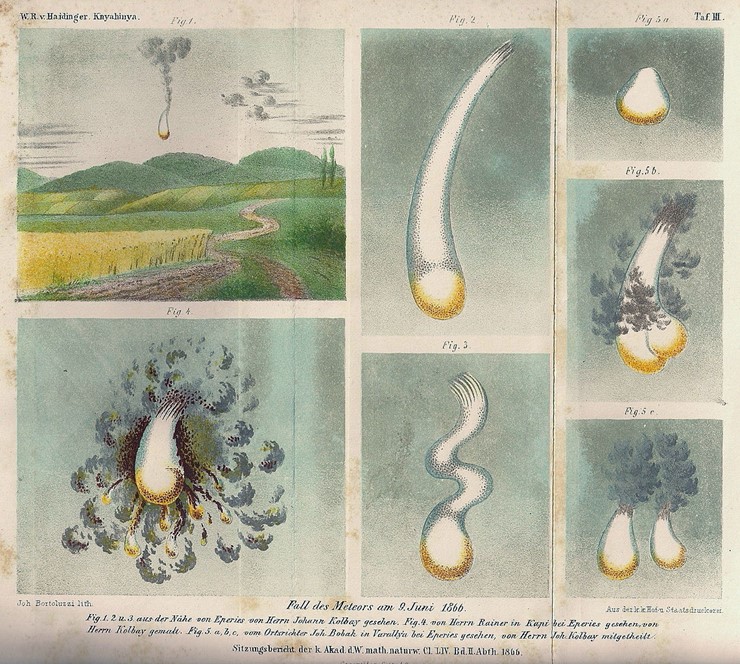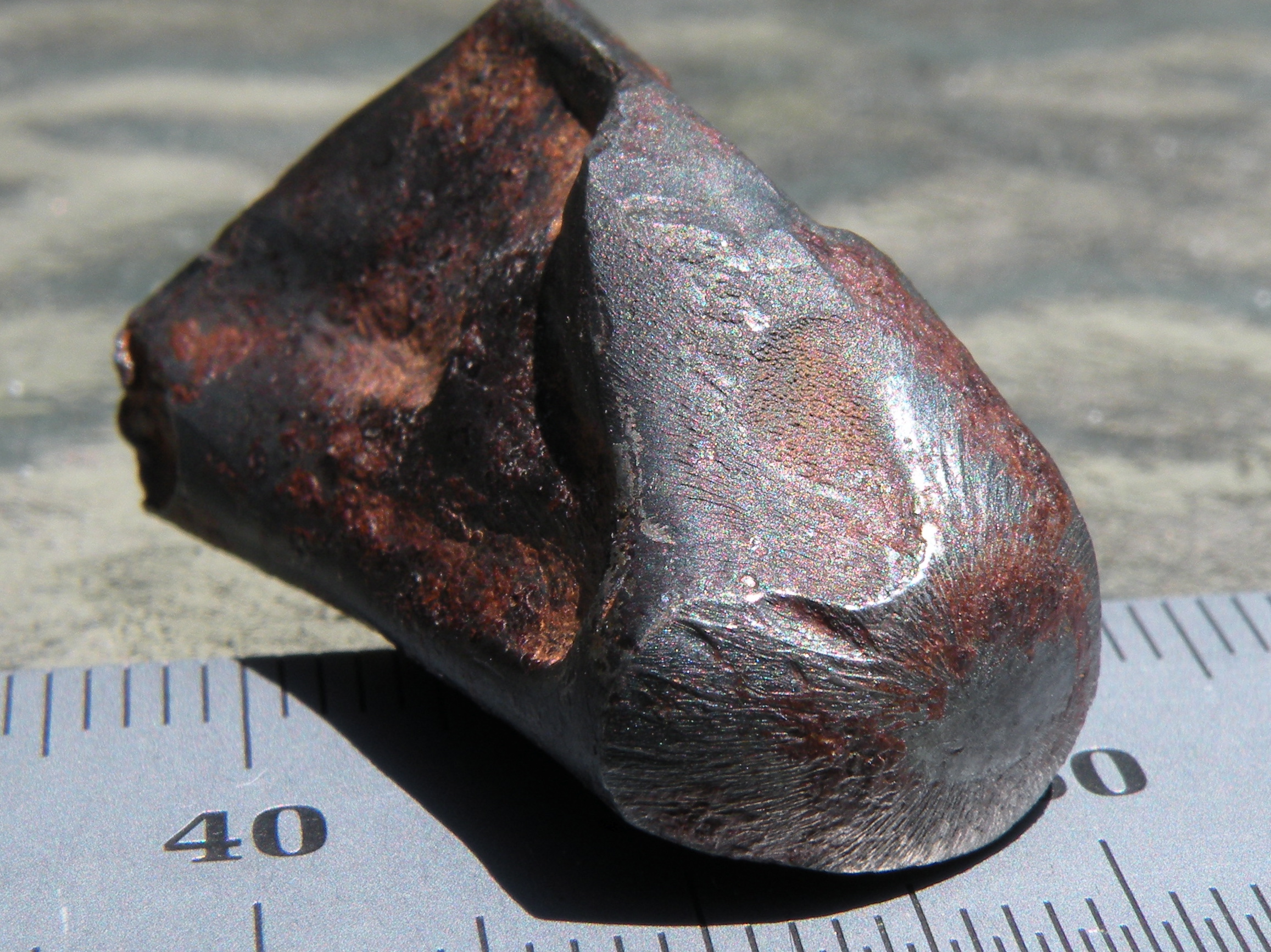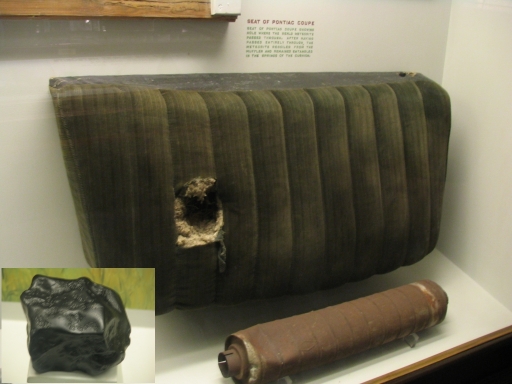
Credit: Wilhelm Ritter von Haidinger, public domain, via Wikimedia Commons
Each year around 17,000 meteorites make it through Earth’s atmosphere to strike the surface of the planet.
With that many impacts, you’d think they would sometimes hit people. But it’s surprisingly rare.
The most damaging effects of such extraterrestrial objects are when large ones break apart in the atmosphere causing an airburst, as we discussed in a prior episode.
These can superheat Earth’s surface and in the distant past have incinerated entire villages.
In China, in the fourteenth and fifteenth centuries, suspected airbursts broke into many tiny meteorites and reportedly killed hundreds of people.
But in modern times, we have very few recorded examples. And to be scientifically verifiable, the meteorite itself must be found.
We have documents from the late 1800’s when meteorites struck a village in Kurdistan, killing one man and paralyzing another. Supposedly one of the meteorites was sent to Istanbul, but it has not been recovered.
In the U.S., in the 1930’s, a meteorite pierced the roof of a car and embedded itself in the car seat. That one was collected but caused no injuries.
In the 1950’s, an eight-pound meteorite shot through a woman’s house, smashed her radio and bounced into her, bruising her hip.
She had to win a court battle to keep it, ultimately paying $500 for the privilege—that’s more than $6,000 today—plus her home repairs. A pretty big “impact” for a small rock.
Background
Synopsis: As space objects impact Earth’s atmosphere, the tiny ones burn up while larger ones tend to break up, producing airbursts and ground impact meteorites. Scientists estimate that more than 17,000 meteorites strike Earth’s surface each year, and while sporadic historical records describe damage by “falling stars” over the last few millennia, verified records of injury or death by direct meteorite impact are extremely rare.
- Space objects come in a variety of sizes, from dust size to miles across. The frequency of Earth impacts decreases as the size of the impactors increases.
- While thousands of tiny ones burn up each day in the atmosphere, midsized objects hit Earth’s surface less frequently.
- The largest objects, like the 7.5 mi (12 km) wide Chicxulub impactor that hit the Yucatan Peninsula 66 million years ago, travel toward Earth much less frequently but can completely change the planet (ED-081 Ripples in Earth’s Crust).
- Research has shown that around 17,000 midsized meteorites strike Earth’s surface each year, ranging in size from 1.75 to 350 oz (50g–10kg).
- Midsized rocky space objects, ranging from inches to yards in diameter (centimeters to meters), are considered meteoroids when outside the Earth's atmosphere, meteors as they travel through Earth’s atmosphere, and meteorites if pieces survive entry through the atmosphere to land on the Earth's surface.

This is a flight-oriented specimen of an iron meteorite called NWA 859, or the Taza meteorite. It maintained a stable orientation of flight while traveling through the atmosphere. The specimen is about an inch (25 millimeters) long.
Credit: Meteoritekid, via Wikimedia Commons - Meteoroids that disintegrate in the atmosphere may fall as meteor showers, which can range from only a few up to thousands of separate individuals.
- A bright meteor is often called a fireball or bolide as it lights up the sky at speeds ranging from 25,000 to 163,000 mph (11–73 km/s). Meteors burn up in the thermosphere and mesosphere, from about 75 to 45 mi (120–70 km) above Earth’s surface.
- In 2022, more than 1,600 space objects between 3.5 to 3,450 ft (1–1,052 m) were tracked within 20 lunar distances of Earth by NASA.
- Midsized rocky space objects, ranging from inches to yards in diameter (centimeters to meters), are considered meteoroids when outside the Earth's atmosphere, meteors as they travel through Earth’s atmosphere, and meteorites if pieces survive entry through the atmosphere to land on the Earth's surface.
- While references regarding the consequences of possible impact events are found occasionally in historical records, verifiable meteorite deaths and injuries are rare.
- Some references are quite benign, like the May 8, 2023, meteorite that crashed through a bedroom in New Jersey. It was 4 x 6 inches (10 x 15 cm) in size and was still warm to the touch.
- In September 29, 1938, a meteorite punched a hole through a garage roof, tearing through a seat, bouncing off a muffler and embedding itself back into the seat cushion of a 1928 Pontiac Coupe.

Photo of the car seat and muffler hit by the Benld meteorite with the 4.3 x 3.5 x 3.1 inches (110 x 90 x 80 millimeters) meteorite inset. The meteorite and portions of the car are now on display at the Field Museum of Natural History in Chicago.
Credit: Shsilver at English Wikipedia, via Wikimedia Commons - We described the effects of three midsized asteroid impacts that occurred in Russia in 2013 (Chelyabinsk, with 1600 indirect injuries), 1908 (Tunguska), and in Jordan (Tall el-Hammam) around 1700 BC in ED-146 Airbursts. Some additional events are described in Chinese historical texts:
- In AD 1490, a suspected airburst with walnut- to goose egg-sized meteorites is reported to have killed up to 10,000 people in Qingyang, a town located between the modern cities of Beijing and Shanghai.
- In AD 1341, “iron rain” fell in China’s southwestern Yunnan Province killing an unknown number of people and animals.
- In AD 616, a “shooting star” was described as the cause of the collapse of a wall during a military campaign, killing 10.
- Historians require adequate documentation of the death or injury as well as physical evidence of the meteorite for verification of cause of death.
- The oldest potentially verifiable record of a person dying by meteorite was recently found in records of the Ottoman Empire that were just digitized.
- On the night of August 10, 1888, at around 8:30 p.m., the streak of a bright fireball lit the sky before it exploded, raining “stones” for 10 minutes on a pyramid shaped hillside near Sulaymaniyah in the Kurdistan region of modern Iraq.
- One resident was killed while another man was paralyzed by direct meteorite strikes as reported by local officials in three documents forwarded to the sultan.
- Meteorites from the event were said to have been collected, and one “stone piece” was sent to the Grand Vizier, but none have been located and confirmed at this point.
- Scientists plan to travel to the area to search for the meteorites to better document the event after Covid-19 restrictions ease. If physical evidence of the impact is found, this will be the only confirmed record of a “death by meteorite.”
- The earliest verified injury by a meteorite occurred in 1954 when Ann Hodges was struck while resting in her home in Talladega County in central Alabama.
- She was napping on her living room couch around midday when the meteorite crashed through the ceiling, hit a radio, and smashed into her hip, leaving a large bruise.

A policeman holds the 8.5 pound (3.85 kilogram) meteorite that crashed through Elizabeth Hodges ceiling on November 30, 1954, striking her in the hip. This was the first verified meteorite injury.
Credit: University of Alabama Museums - She thought it was an explosion but found a grapefruit sized rock on the floor—an 8.5 lb (3.85 kg) meteorite. The event upended the rest of her life.
- After a court battle about ownership, the Hodges family paid $500 for the meteorite, using it as a doorstop before donating it to the Alabama Museum of Natural History.
- In 2017, Christie’s auction house sold another piece of the same meteor for $7,500, which amounted to $728 per gram at a time when 24K gold was valued at just $39.05 per gram.
- She was napping on her living room couch around midday when the meteorite crashed through the ceiling, hit a radio, and smashed into her hip, leaving a large bruise.

